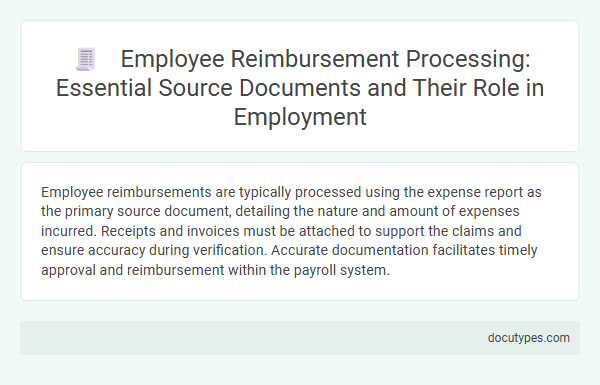Employee reimbursements are typically processed using the expense report as the primary source document, detailing the nature and amount of expenses incurred. Receipts and invoices must be attached to support the claims and ensure accuracy during verification. Accurate documentation facilitates timely approval and reimbursement within the payroll system.
Introduction to Employee Reimbursement Processing
Employee reimbursement processing requires accurate source documents to ensure correct payment and record-keeping. The primary source document used is the employee's submitted expense report, which details all reimbursable costs incurred. Your employer relies on these reports along with supporting receipts to validate and process reimbursements efficiently.
Understanding Source Documents in Employment Context
| Source Document | Description | Purpose in Employee Reimbursements |
|---|---|---|
| Expense Report | A detailed form completed by employees listing all expenses incurred during business activities, including receipts and justifications. | Serves as the primary document for verifying and validating expenses before reimbursement. |
| Receipts | Official proof of purchase or payment, often issued by vendors, showing date, amount, and type of expense. | Provides evidence to support claims made in the expense report and ensures compliance with company policies. |
| Travel Authorization | Pre-approved document granting permission for business travel, listing approved expenses and limits. | Establishes the scope of reimbursable travel expenses and prevents unauthorized costs. |
| Purchase Orders | Formal document issued to vendors specifying items or services ordered by the employee or department. | Confirms pre-approved expenditures related to employee duties and supports reimbursement claims. |
| Payment Vouchers | Internal document used by accounting to process payments after verifying the legitimacy of expenses. | Finalizes the reimbursement process by authorizing disbursement to the employee. |
Types of Employee Reimbursement Claims
Employee reimbursements require accurate source documents to ensure timely and correct processing. Understanding the types of reimbursement claims helps streamline your submission and approval process.
- Receipts - Official proof of purchase or payment, essential for validating expense claims.
- Expense Reports - Detailed forms listing expenses incurred, providing a structured overview for approval.
- Authorization Forms - Pre-approval documents that confirm approved expenditures before reimbursement.
Using the correct source documents for your reimbursement claims minimizes errors and accelerates payment processing.
Essential Source Documents for Reimbursement Requests
Processing employee reimbursements requires accurate source documents to validate expenses. Essential source documents ensure compliance and facilitate timely reimbursement.
- Expense Report - Employees submit detailed reports listing expenses for reimbursement with dates and amounts.
- Receipts and Invoices - Original receipts or vendor invoices provide proof of expenditure and support claim verification.
- Approval Forms - Manager or supervisor approvals validate the legitimacy of the reimbursement request.
Importance of Accurate Documentation in Reimbursement
Accurate source documents are essential for processing employee reimbursements to ensure transparency and prevent errors. Your reimbursement claims depend on clear, precise documentation that validates expenses quickly.
- Expense Receipts - These provide proof of purchase and are crucial for verifying the legitimacy of employee expenses.
- Travel Itineraries - Detailed itineraries support claims related to business travel and help confirm dates and destinations.
- Reimbursement Request Forms - These forms capture all necessary information and serve as the formal submission for reimbursement approval.
Common Challenges in Collecting Source Documents
Employee reimbursements require accurate source documents such as receipts, invoices, and travel expense reports. Common challenges in collecting these documents include missing receipts, illegible details, and delayed submissions. Ensuring you gather all necessary paperwork promptly helps avoid reimbursement delays and accounting errors.
Verification and Approval Procedures for Source Documents
Employee reimbursement processing relies primarily on source documents such as expense reports, receipts, and purchase orders. These documents provide essential verification of the expenses incurred by employees during business activities.
Verification involves cross-checking receipts against the expense report to ensure accuracy and legitimacy. Approval procedures require authorized personnel to review and sign off on the documents before reimbursement is processed. This systematic validation helps maintain financial control and compliance with company policies.
Recordkeeping and Compliance Requirements
The primary source document used for processing employee reimbursements is the expense report, which details all incurred costs requiring reimbursement. Receipts and invoices must be attached to validate each expense, ensuring accuracy and transparency.
Proper recordkeeping of these documents is essential for compliance with tax regulations and internal policies. You must retain expense reports and supporting receipts for a specified period, typically seven years, to satisfy audit and legal requirements.
Impact of Source Documents on Payroll and Taxation
Which source document is essential for processing employee reimbursements? Expense reports are commonly used to verify and approve reimbursement claims. The accuracy of these documents directly impacts payroll calculations and tax compliance for your organization.
Which Source Document Is Used for Processing Employee Reimbursements? Infographic

